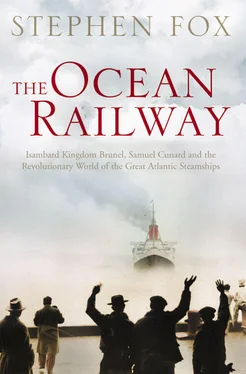Though his careful manners concealed it, he in fact remained ferociously ambitious. During the 1830s he became a resident director of the Bank of British North America, served as the local agent of the London-based General Mining Association (in charge of coal mines in Nova Scotia and Cape Breton Island), and bought up hundreds of thousands of acres of timber and rental land on Prince Edward Island – all before the most ambitious act of his life. The Royal William did not entirely kill his interest in steam navigation, as he ran more modest steamboats in the local coastal traffic. At times he took extravagant risks, skirting financial ruin by moving fluid capital from one enterprise to launch yet another. Most of his undertakings, though, were apparently protected by the famous Cunard luck. On one occasion late in 1832, Haligonians waited anxiously for another overdue vessel to arrive. ‘ As it isone of Cunard’s ships,’ William Blowers Bliss mused, ‘I suppose she will get in at last, he is too lucky to lose her unless she be well insured.’
It was not only luck, of course. Nor, as far as Cunard was concerned, was it the guiding hand of Providence. In his letters he would make passing religious references. ‘ If it shouldplease God that we should all live to see the next year,’ he might write, ‘…if I should be spared I hope I may yet be useful to our concern.’ But this was just obeisance to an expected form, perhaps inserted simply to please a pious correspondent. Cunard had no real religious convictions. On his deathbed, when his son Ned suggested the attention of a clergyman, Sam declared ‘ that he did notfeel and admit and believe’ – a dying confession that told the stark if unwanted truth.
What he really believed in was himself, the hard, driving, ruthless, tireless engine at the core of his being. Over his lifetime, he lived out the story so beloved by minor novelists of the nineteenth century: the poor boy from the provinces who worked hard, curbed his vices, hoped for the best and took optimistic chances, came to the big city and made his deserving way, and finally seized the most coveted material rewards his society offered. He bridged several distinct eras, from a late-eighteenth-century colonial frontier to high Victorian London. Across these steadily more progressive times, Cunard was a quite modern personality, focused intensely and narrowly on the ongoing prosperity of his enterprises. He prudently adopted new technologies when they seemed useful, measuring his success by profits and numbers that he could see and weigh and count. He trusted nothing but his immediate family and his own unquenchable ambitions.
4. Ships as Engineering: Isambard Kingdom Brunel
The dream of starting a transatlantic steamship line depended in equal measure on enterprise and engineering, or money and machinery. Engineering had to come first. Once it seemed that engines, boilers and ships had been improved enough to bear the overpowering demands of the North Atlantic Ocean, moneyed investors might come forth to launch the enterprise. Almost nothing in history is truly inevitable; any major event or turning point could have turned out quite differently if shaded by other twists of luck or contingency. But given the ongoing progress in steamship technology, the swelling commercial and political pressures for faster, surer links between Europe and America, and many interested parties on both sides of the ocean ready to invest in any plausible scheme, transatlantic steam seemed virtually certain. The only lingering questions were how soon and by whom. ‘ Indeed, all thingsconsidered, ’ said the Mechanics’ Magazine of London in 1837, ‘the strangest thing about the matter is, that the object should not have been effected many years ago.’
Ocean steamships became the largest, most complicated machines yet devised. As such, they drew on engineering developments in many different fields. British engineering in general was now approaching its nineteenth-century zenith, a dazzling peak moment of practical imagination, commercial success and global impact. British engineers were, for the time being, the best in the world. They had started the first Industrial Revolution and then provided the models for its cloning in Europe and North America. Great Britain was producing far more coal, iron, machinery and technological optimism than any other country. The earliest successful Atlantic steamships could not have come from anywhere else.
Engineering as an exact science was barely a century old. It had originated in France, before the advent of the steam engine, as a real-world application of the Age of Reason. The term ‘engineer’ traditionally meant someone who built only war machines and fortifications; ‘civil engineering’ thus came to mean similar pursuits carried out in peacetime. Influenced by then-current philosophical emphases on rationalist modes of thought, French engineers adapted new ideals of mathematical precision, measurability and experimentation to their practical building tasks. Such pioneers as Pierre Bouguer and Charles Augustin Coulomb invented the fields of structural analysis, applied mechanics and hydraulics. The first engineering schools appeared in eighteenth-century France and long remained the most exacting such institutions in the world.
In Great Britain, engineering at the outset was more intuitive and direct, neither assisted nor impeded by much conscious philosophical baggage. The first British civil engineers – John Smeaton, Thomas Telford, John Rennie – mainly worked with the traditional materials of wood, stone and masonry to build improved roads, bridges and harbours. In particular, they constructed canals, the prevailing transportation fad during the decades around the turn of the nineteenth century. A canal, a water medium, had to remain as level as possible throughout its course. That meant rearranging the natural environment to an unprecedented degree: building up embankments, running high viaducts across valleys, bridging rivers, cutting down the smaller hills, and tunnelling through larger ones. The Sapperton Tunnelon the Thames and Severn Canal, finished in 1789, was over two miles long – an amazing feat at the time. Humans were imposing their will on nature as never before, for all to see, and by their success were encouraged to entertain yet more Promethean ambitions for themselves. As civil engineering matured, it shed its original honest-workman’s aura, became a more socially acceptable career, and professionalized itself. The Institution of Civil Engineers was founded in 1818, mainly by canal men. ‘ Civil Engineering isthe art of directing the great sources of power in Nature for the use and convenience of man,’ explained an ICE leader. ‘The most important object of Civil Engineering is to improve the means of production and of traffic.’
The next generation of British engineers typically adopted newer building materials and power, especially iron, coal and steam engines. The line between the two groups was not quite that stark; Telford and Rennie, from the first generation, had used cast iron in their bridges as early as the 1790s. The real demarcation came down to function. The founding civil engineers built objects that did not move. The later mechanical engineers, as they were called, built machines that snorted and clanked across the landscape. One was best known for canals and bridges, the other for railways and steam power. Many individuals continued to work at every type of engineering. But with the narrowing of newer specializations, and the relentless deepening of requisite knowledge in any given field, the civils and mechanicals diverged ever more sharply, sometimes feuding with each other. The Institution of Mechanical Engineers, started in 1846 by railway men, gave this hardening division an organized boundary.
Читать дальше












